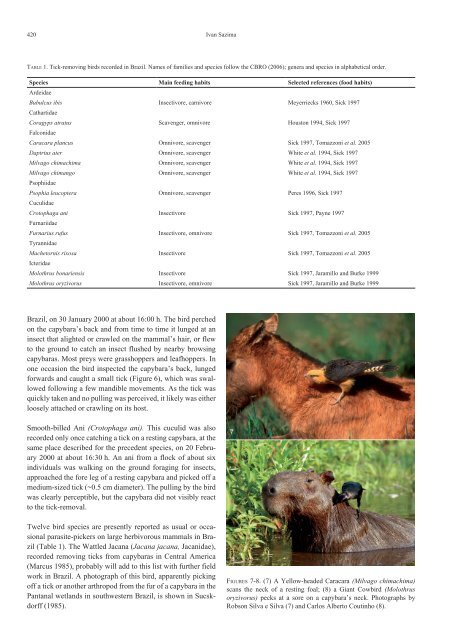Create successful ePaper yourself
Turn your PDF publications into a flip-book with our unique Google optimized e-Paper software.
420 Ivan Sazima<br />
table 1. Tick‑removing birds recorded in Brazil. Names of families and species follow the CBRO (2006); genera and species in alphabetical order.<br />
Species<br />
Ardei<strong>da</strong>e<br />
Main feeding habits Selected references (food habits)<br />
Bubulcus ibis<br />
Catharti<strong>da</strong>e<br />
Insectivore, carnivore Meyerriecks 1960, Sick 1997<br />
Coragyps atratus<br />
Falconi<strong>da</strong>e<br />
Scavenger, omnivore Houston 1994, Sick 1997<br />
Caracara plancus Omnivore, scavenger Sick 1997, Tomazzoni et al. 2005<br />
Daptrius ater Omnivore, scavenger White et al. 1994, Sick 1997<br />
Milvago chimachima Omnivore, scavenger White et al. 1994, Sick 1997<br />
Milvago chimango<br />
Psophii<strong>da</strong>e<br />
Omnivore, scavenger White et al. 1994, Sick 1997<br />
Psophia leucoptera<br />
Cuculi<strong>da</strong>e<br />
Omnivore, scavenger Peres 1996, Sick 1997<br />
Crotophaga ani<br />
Furnarii<strong>da</strong>e<br />
Insectivore Sick 1997, Payne 1997<br />
Furnarius rufus<br />
Tyranni<strong>da</strong>e<br />
Insectivore, omnivore Sick 1997, Tomazzoni et al. 2005<br />
Machetornis rixosa<br />
Icteri<strong>da</strong>e<br />
Insectivore Sick 1997, Tomazzoni et al. 2005<br />
Molothrus bonariensis Insectivore Sick 1997, Jaramillo and Burke 1999<br />
Molothrus oryzivorus Insectivore, omnivore Sick 1997, Jaramillo and Burke 1999<br />
Brazil, on 30 January 2000 at about 16:00 h. The bird perched<br />
on the capybara’s back and from time to time it lunged at an<br />
insect that alighted or crawled on the mammal’s hair, or flew<br />
to the ground to catch an insect flushed by nearby browsing<br />
capybaras. Most preys were grasshoppers and leafhoppers. In<br />
one occasion the bird inspected the capybara’s back, lunged<br />
forwards and caught a small tick (Figure 6), which was swal‑<br />
lowed following a few mandible movements. As the tick was<br />
quickly taken and no pulling was perceived, it likely was either<br />
loosely attached or crawling on its host.<br />
Smooth‑billed Ani (Crotophaga ani). This cuculid was also<br />
recorded only once catching a tick on a resting capybara, at the<br />
same place described for the precedent species, on 20 Febru‑<br />
ary 2000 at about 16:30 h. An ani from a flock of about six<br />
individuals was walking on the ground foraging for insects,<br />
approached the fore leg of a resting capybara and picked off a<br />
medium‑sized tick (~0.5 cm diameter). The pulling by the bird<br />
was clearly perceptible, but the capybara did not visibly react<br />
to the tick‑removal.<br />
Twelve bird species are presently reported as usual or occa‑<br />
sional parasite‑pickers on large herbivorous mammals in Bra‑<br />
zil (Table 1). The Wattled Jacana (Jacana jacana, Jacani<strong>da</strong>e),<br />
recorded removing ticks from capybaras in Central America<br />
(Marcus 1985), probably will add to this list with further field<br />
work in Brazil. A photograph of this bird, apparently picking<br />
off a tick or another arthropod from the fur of a capybara in the<br />
Pantanal wetlands in southwestern Brazil, is shown in Sucsk‑<br />
dorff (1985).<br />
FiguRes 7-8. (7) A Yellow‑headed Caracara (Milvago chimachima)<br />
scans the neck of a resting foal; (8) a Giant Cowbird (Molothrus<br />
oryzivorus) pecks at a sore on a capybara’s neck. Photographs by<br />
Robson Silva e Silva (7) and Carlos Alberto Coutinho (8).

















